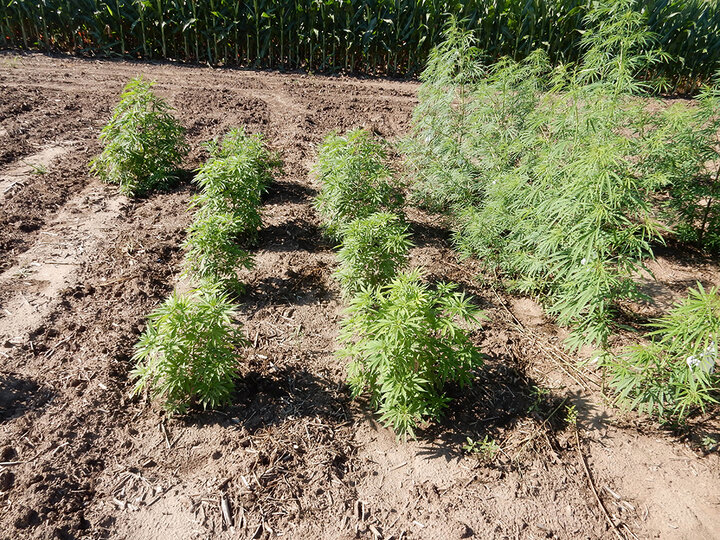Hemp (Cannabis sativa) has been a major crop globally for centuries, used for the production of fiber, medicine, and other products. Its production has been regulated since 1937, along with bans on psychoactive substances such as marijuana, cocaine, and opiates. Production of hemp, including industrial hemp, peaked in 1943 but was fully banned in the 1970s. (Hemp is differentiated from marijuana by its lower levels of THC (tetrahydrocannabinol), the psychoactive chemical in the plant. The dry weight of the hemp flower – or any other plant part – must be less than 0.3% Delta-9 THC.)
| State | 2017 | 2018 |
|---|---|---|
| Colorado | 9,700 | 21,578 |
| Kentucky | 3,271 | 6,700 |
| Minnesota | 1,205 | 710 |
| Montana | 542 | 22,000 |
| Nevada | 417 | 1,881 |
| New York | 2,000 | 2,240 |
| North Carolina | 965 | 3,184 |
| North Dakota | 3,020 | 2,778 |
| Oregon | 3,469 | 7,808 |
| Tennessee | 200 | 3,338 |
| Vermont | 575 | 1,820 |
| Wisconsin | NA | 1,850 |
| Other states | 349 | 2,289 |
| Total | 25,713 | 78,176 |
The US domestic markets for industrial hemp products have been supplied primarily by China and Canada. France is the global leader in industrial hemp production.
In the 2018 farm bill, industrial hemp was removed from the controlled substance list and hemp farmers were made eligible for federal crop insurance and researchers were enabled to apply for federal grants. In that year US hemp production increased to 78,176 acres, an increase of more than 200% from 2017 (Table 1), when hemp was grown for research.
Nebraska legalized hemp production for fiber, grain, or cannabidiol (CBD) in 2019, with the condition that plant parts of industrial hemp have a THC concentration of less than 0.3%. Production and use of marijuana and THC for medical and recreational purposes remain illegal in Nebraska.
University of Nebraska-Lincoln Extension agricultural publications generally are based on the interpretation of research information from Nebraska or elsewhere in the Midwest. However, such information is not available relative to hemp production due to previous restrictions on research in the U.S. This publication relies heavily on research findings from Europe and Canada (Struik et al., 2000). Since the production of hemp is beginning anew in Nebraska, we considered it important to offer information and guidelines now with the expectation of substantial changes with increased research findings and farmer experiences. Therefore, feedback and information to the authors to improve the information provided in these three stories is requested.
On a Hemp Program website, the Nebraska Department of Agriculture has posted information on the pilot program and application process, frequently asked questions, and a list of pesticides available for hemp production.
"We [NDA] look forward to USDA providing federal guidelines to help ensure the success of a full program for 2020 and beyond," the site notes.
Rapid increases in hemp production are projected due to demand for CBD and other hemp products. The president of the U.S. Hemp Authority, an industry group, wrote in 2018 “the hemp oilseed, fiber, and extract industries are at the threshold of an economic revolution.”
Many questions remain. Will the health benefits of CBD be confirmed? How will farmers keep plants from exceeding the legal limit of 0.3% THC, the psychoactive component of marijuana? Which hemp varieties perform best in which environments? What are good agronomic practices for hemp production?
Good Agronomic Practices for Hemp

The information basis for determining good agronomic practices is weak due to little research or production experience in the US since the 1940s. Still, there is information from other countries and recent research and production experiences in the US.
Hemp can be productive on marginal cropland, but production is optimized with highly productive land. Like corn and sorghum, it is a summer crop. It is better adapted to temperate than to tropical zones. It is best adapted to well-drained soil, warm days, and cool nights, and benefits from an adequate supply of water and nutrients. Hemp is especially sensitive to drought during the first six weeks of growth, but late summer drought and high temperatures are also of concern due to hastened maturity and shortened plants.
Some suggested optimal soil properties for hemp production include:
- soil pH of 6 to 7,
- well-drained loam soil,
- cation exchange capacity (CEC) greater than 12 meq/100 g with Mg accounting for less than 20% of CEC,
- higher than 30 ppm Bray-1 P,
- higher than 150 ppm exchangeable K, and
- little or no soil compaction, soil crusting, and high clay content soil.
These soil criteria have not been validated for Nebraska and may be more appropriate for high-value CBD than for fiber and grain production. These critical values for P and K are very high compared with those of corn, sorghum, and soybean in Nebraska.
Hemp is normally a dioecious species with male and female plants, but monoecious varieties with male and female flowers on the same plant are available. Hemp is generally a short-day, photoperiod-sensitive plant which, as in soybean, is an important consideration in variety selection. The day length to trigger flowering can be as long as 14 hours for varieties in Canada (Canda and Delores) to 12 hours for lower latitudes. However, some varieties are insensitive to day length and flower according to age. Crop stress and cool temperatures should be avoided to prevent the development of high THC levels. Levels of THC for industrial hemp are not affected by cross-pollination with marijuana, but THC is reduced in marijuana by cross-pollination with industrial hemp.
Good agronomic practices for grain or fiber production and CBD production differ greatly. Practices for other specialized products are likely to require further adaptation. For more information, see these CropWatch stories:

